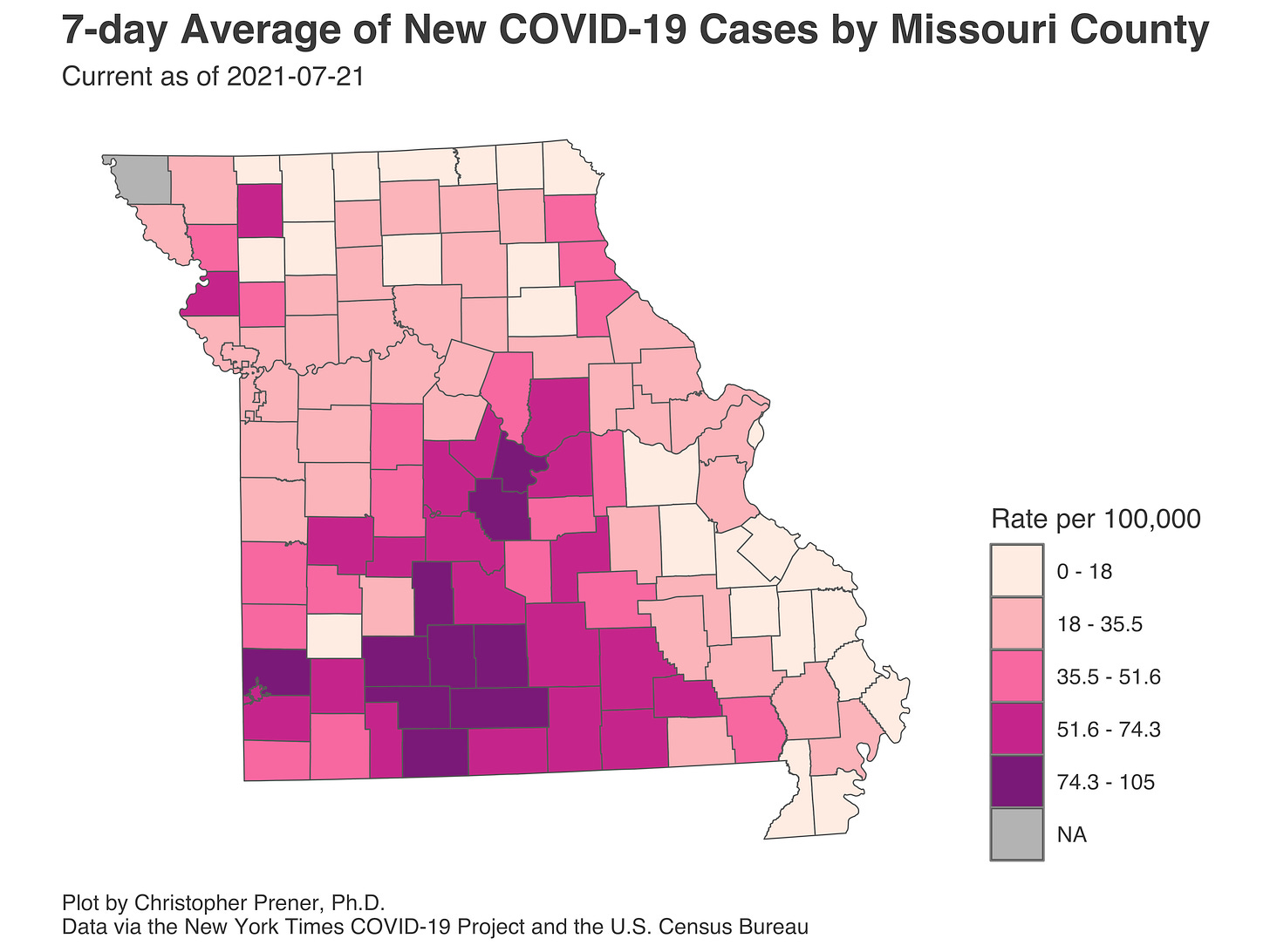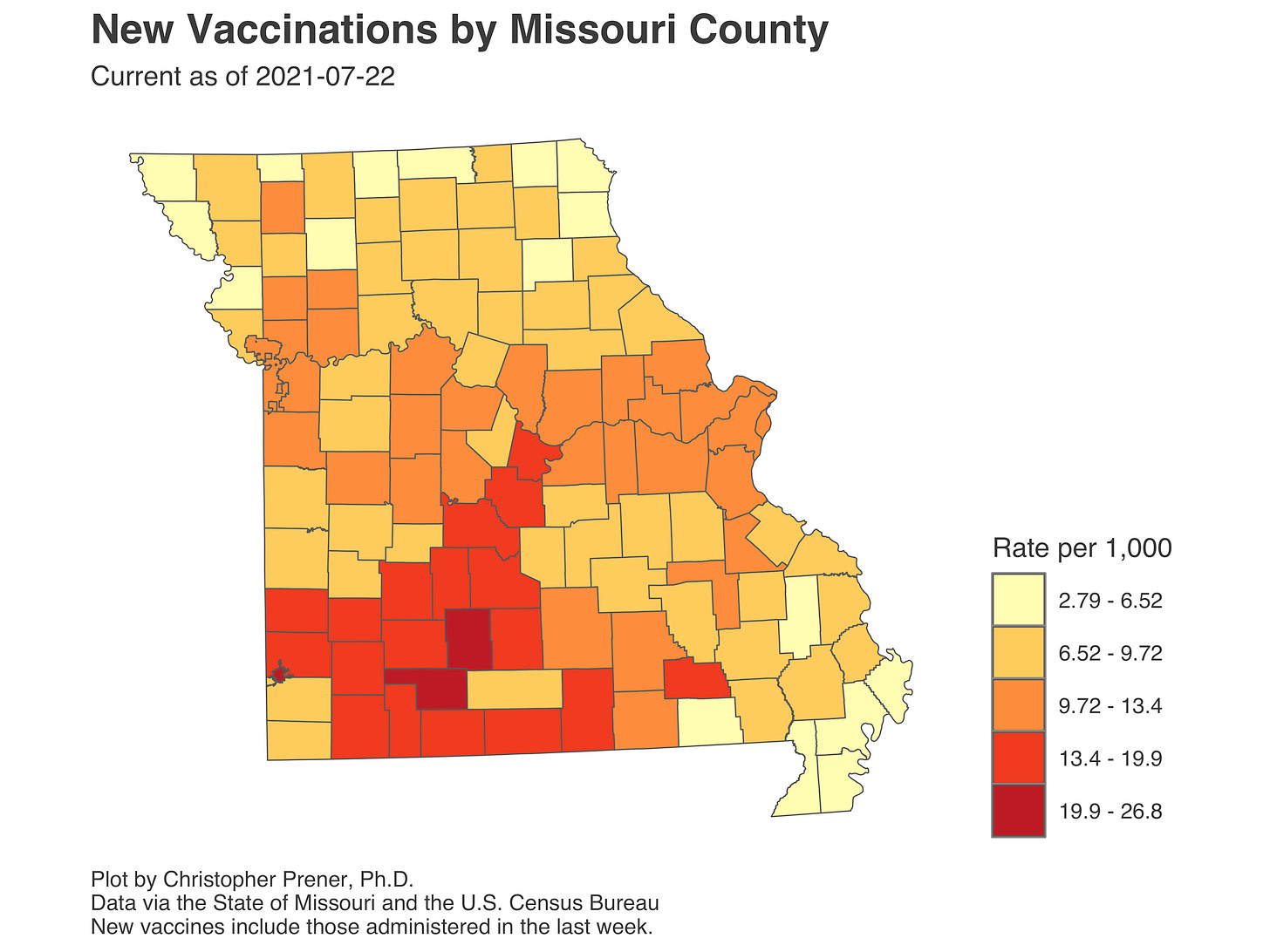Tonight’s newsletter is a long one. I have a lengthy update on new case, hospitalization, and mortality trends in Missouri and the wider “Ozark cluster” that includes several of our neighboring states. I also share updates on vaccinations, and discuss two articles I read this week on breakthrough cases that I found particularly insightful. Be well, get vaccinated, and wear your mask if you already are fully immunized! - Chris
COVID-19 by the Numbers
Total cases in MO: 668,794 (+15,352 from last Thursday)
7-day average of new cases per day in MO: 2,193.14 (+585.57 from last Thursday)
Counties with the highest per capita rates (per 100,000) of new cases per day this past week:
Cole (104.99 per 100,000), Taney (101.29), Miller (88.4), Webster (86.28), Dallas (83.99), Greene (83.75), Christian (83.23), Jasper (78.19), and Wright (78.09)
Total deaths in MO: 10,164 (+81 from last Thursday)
7-day average of new deaths per day in MO: 11.57 (-1.29 from last Thursday)
Case and mortality numbers are current as of Wednesday, July 21st. Additional statistics, maps, and plots are available on my COVID-19 tracking site.
Illness Trends in the Past Week
We’ve now had just over a week where we added more than 2,000 new cases per day, on average, in Missouri. I’ve mentioned before that comparisons across time are tricky with COVID-19 case counts because of testing and data changes, especially in 2020. However, I feel pretty confident characterizing what we are experiencing now as our third sustained wave of new cases (the first was in spring 2020, and the second was during the fall and winter of 2020 into early 2021). Unfortunately, my workhorse regional plots don’t do a great job sharing this history because testing was limited in the first few months of the pandemic.
The first pandemic wave was all about St. Louis, as best we can tell from the case data that we have. However, the fall and winter wave affected the entire state, though Kansas City did not have quite the same rates that other parts of Missouri experienced.
If you look at the very righthand edge of the plot above, however, you can see that we have essentially flipped the regional narrative from the first wave. This is an “outstate” wave so far, heavily affecting rural counties and smaller metro areas. Of the two major cities, Kansas City has had the higher rates of new cases to date.
When we break down the metropolitan areas in Missouri, you get an even better sense of how the third wave of the pandemic is affecting Missouri. Joplin and Springfield are experiencing some of the most challenging days they have had during the pandemic so far (again, acknowledging the challenges of comparing case rates across time). New case rates are also up in the St. Joseph, Columbia, and Jefferson City metro areas.
The increase in Mid-Missouri, especially the rapid increase in Jefferson City, has been particularly striking. Rates escalated quickly in Cole County in particular and have continued to climb, albeit at a slightly slower pace over the past couple of days. Of all American counties with more than 10,000 residents, only one has a higher rate of new cases right now than Cole County.
This increase, combined with the more widespread but smaller increases in Boone and other neighboring counties, solidifies Mid-Missouri as the northern edge of what I have been calling the “Ozark cluster.” This is a four-state area extending from Southeast Kansas and Northeast Oklahoma through all of the Missouri counties that stand out in the map below through to Northern Arkansas.
If you look at the New York Times map of new COVID-19 cases, you can get a really clear sense of what I mean by the “Ozark cluster.” Missouri is by far the most concerning of these four states. The rates of new cases in Oklahoma and Kansas are quite a bit smaller, and Arkansas has a notably lower hospitalization rate. The National Institutes of Health Director called this out a week ago, noting that Missouri was the most concerning state in the U.S. COVID-wise. I see no reason for that sentiment to have changed in the past week.
If anything, my concern continues to grow. For one, hospitalization rates have continued to swing upward. This is especially true in the Joplin and Springfield metros, where they had already matched their fall and winter wave highs as of July 9th. From everything that hospital administrators have reported since, I think we can expect that hospitalization rates in those two metros will outstrip anything we have seen previously when HHS includes more of July in their next two updates.
Both the St. Joseph and Jefferson City metros also stand out here as well. What I think is especially notable is that the increase in Jeff City happened before the precipitous increase in new cases I mentioned above. Some of this is likely due to growing cases in adjacent areas, like the Lake of the Ozarks. It also fits with a pattern I’ve observed since May, however - hospitalizations have risen along or even before rates of new cases in metro areas.
This is another reason I am concerned about. St. Louis, as I said above, has so far been spared higher rates of new cases. Instead, they have grown very slowly and remained well below other parts of Missouri (except for counties around Cape Girardeau). However, look at the hospitalization trend over the past three weeks. It tracks with what we have seen in other metros: modest increases in new cases with a steeper increase in hospitalizations.
From reading these data, I feel that we should be apprehensive about a rise in new case rates in St. Louis. We should also be very worried about them rising especially quickly from what we have seen in Cole County.
I am also worried because of who is getting sick in St. Louis. Both the City and the County put out a joint press release a couple of days ago stating that African Americans make up 80% of new cases in those two jurisdictions. From what I have been told since, hospitalizations here are also skewing more heavily towards younger African American patients. This is not surprising given what we know about case rates and where vaccinations in the City and County are highest. Given that the Black community has already had some of the highest rates of illness (not pictured) and the highest mortality rates (see below), the new trends underscore the need to see additional interventions through a racial equity lens.
This week, the St. Louis Pandemic Task Force highlighted some but not all of these trends in an urgent press release. I wish they had placed a bigger emphasis on the racial disparities they see in their hospitals. However, I appreciated their focus on the need for universal masking to return. Given everything I laid out above, I believe now is the time for St. Louis and Kansas City to act decisively to follow the advice of the Task Force and bring back mask mandates. We could also do other things, including limiting capacity or access to high-risk indoor spaces and ensuring that large numbers of our neighbors are not evicted when the CDC moratorium expires at the end of July.
These measures won’t be popular, but every data point we have suggests a rapid deterioration in Missouri. This includes mortality, which for the first time in this latest wave of cases, is also showing a steady increase through the end of June. It drops again, but I believe that is noise from the abysmally slow rate at which Missouri confirms COVID deaths. I anticipate seeing the red line track steadily upward as we gain more data about deaths during July.
Vaccination Trends in the Past Week
There has been very little shift in vaccination patterns over the past week. Our rates remain quite low - we only have a handful of counties with rates of initiation (nevermind completion) near or above half of their total population. This is a big part of why we are leading the nation right now in COVID-19 cases.
The messaging that we see about the need to get vaccinated immediately does seem to be impacting rates in Southwest Missouri. The counties in the region continue to lead the state in new vaccinations. This is excellent, but as I have noted before, rates remain far too low overall. Moreover, people getting vaccinated today are not fully protected for weeks.
For these reasons, I do not believe we can rely solely on vaccinations. Of course, we need them and need to increase uptake, but we also need non-pharmaceutical interventions urgently. As I said above, these tools include universal masking, placing restrictions on the most high-risk indoor spaces, and ensuring people can stay in their homes.
Into the Weeds
I have read two articles this week that I want to suggest to folks, both having to do with breakthrough cases. We see more and more reports of breakthrough cases, which I think are jarring to many folks who see the vaccines as a safety net against infection. At least 162.2 million Americans have been vaccinated. It is so critical to keep this denominator in mind because it is a huge number. Imagine only 1% of people vaccinated experience a breakthrough case (note: this is a totally hypothetical number). At that rate, we would expect 1,622,000 people to experience breakthrough cases.
That seems like a lot of people, but not in the context of the total number of vaccinated individuals. It’s hard for our brains to grapple with large numbers like this, but the underlying message is that rare events happen all of the time when we have a big enough sample size. We are seeing that with breakthrough cases now.
We also do not hear much about who is experiencing breakthrough cases, but we would expect them more among those with advanced age or pre-existing conditions that impact their immune systems. Not everyone has the same risk of a breakthrough case. We would also expect more breakthrough cases in places where community transmission is higher - this includes nearly all of Missouri right now - because vaccinated individuals are being exposed to higher viral loads.
The other article I found useful spent some time talking about the specific messaging we have heard about how serious these breakthrough cases are. A substantial proportion of the hospitalized people and almost all of the deaths are among unvaccinated individuals. Vaccinated individuals should expect to have only mild cases of the virus, but this article clearly explains how mild COVID can still feel like you are exceptionally sick. This is critical to remember as well.
The heuristics we have about safety are critical to interrogate and update over time as we get new information. Given what we are learning about the real-world effectiveness of vaccines, we should feel confident that they work very well at preventing serious illness. That does not mean that we will not hear about millions of breakthrough cases and that some of those people will be very sick (just not nearly as sick, potentially, as they could have been).
Hopefully, these articles help you think about navigating the next few months in Missouri when community transmission will likely remain quite high.
If you like what you see here and don’t already, please subscribe!












